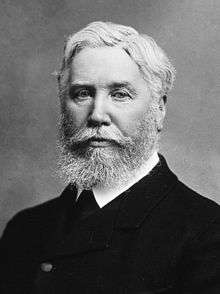James Bell Pettigrew
Prof James Bell Pettigrew FRSE FRS FRCPE LLD (26 May 1834 – 30 January 1908) was a Scottish anatomist and noted amateur naturalist, aviation pioneer and museum curator. He was a distinguished naturalist in Britain, and Professor of Anatomy at St Andrews University from 1875 until his death.
James Bell Pettigrew | |
|---|---|
 | |
| Born | 26 May 1834 Roxhill, Calderbank, Lanarkshire |
| Died | 30 January 1908 (aged 73) |
| Nationality | Scottish |
| Citizenship | United Kingdom |
| Education | University of Glasgow; University of Edinburgh |
Notable work | Design in Nature; Animal Locomotion: or Walking, Swimming and Flying |
| Medical career | |
| Institutions | Royal Infirmary of Edinburgh; Hunterian Museum; Royal College of Surgeons of Edinburgh; University of St Andrews |
| Research | Anatomy; Pathology |
| Awards | Croonian Lectures |
Pettigrew was an internationally acknowledged authority on animal locomotion and bird flight, which informed his invention of an early flying machine. The Wright Brothers studied his most popular work, Animal Locomotion: or Walking, Swimming and Flying which was published in 1873.
Life
Pettigrew was born at Roxhill, near Calderbank in Lanarkshire,[1] the son of Robert Pettigrew and his wife, Mary Bell. He was educated at the Free West Academy in Airdrie. He then studied Arts at the University of Glasgow before transferring to the University of Edinburgh to study Medicine. Pettigrew flourished under the tutelage of John Goodsir with whom he developed a programme of research into the morphology of the human heart. Most unusually, as an undergraduate, he was invited to deliver the Croonian Lectures of the Royal Society and the Royal College of Physicians of London in 1860. In these lectures, Pettigrew advanced a remarkable discussion of the anatomical arrangement of the musculature of the heart. In 1861 he graduated MD from Edinburgh[2] and became House Surgeon at the Royal Infirmary of Edinburgh. From an early age, Pettigrew demonstrated a remarkable flair for morphological analysis and an analytical grasp of natural history.[3]
In 1862, Pettigrew accepted the post of Assistant Curator at the Hunterian Museum of the Royal College of Surgeons in London. He held the position for five years. In 1867 he retired to Ireland (possibly suffering from a psychiatric disorder) to study the flight of birds and bats. He had a passionate interest in animal locomotion and, more particularly, in the theory of flight, and around the turn of the century made several prototypes of an ornithopter of his own design.[3]
In 1868, at the age of 36, Pettigrew was elected a Fellow of the Royal Society. [3]
In 1869 he returned to Scotland to take up an honorary position as Curator of the museum of the Royal College of Surgeons of Edinburgh and employment as pathologist to the Edinburgh Royal Infirmary. In 1873 he was elected a Fellow of the Royal Society of Edinburgh his proposer being Sir Thomas Richard Fraser and later that year was elected a Fellow of the Royal College of Physicians of Edinburgh. [3]
In 1873, Pettigrew published Animal Locomotion: or Walking, Swimming and Flying, his most popular work. In 1875, he was appointed to the Chandos Chair of Medicine and Anatomy at St Andrews University and established a home on The Scores which he called Swallowgate because of its situation which allowed him to observe birds in flight.
Over several subsequent years, Pettigrew assembled his magnum opus Design in Nature, published in three volumes and lavishly illustrated with engravings and photographs.
Its publication was completed in 1908.
In this work, he showed some indifference to Darwinism and mainstream evolutionary biology, favouring teleological points of view instead. His reputation was subsequently overshadowed by that of his colleague D'Arcy Wentworth Thompson.
Pettigrew lived at 4 Randolph Place in Edinburgh's West End.[4]
In 1889, Pettigrew was elected President of the Harveian Society of Edinburgh.
He died at his home in St Andrews in 1908. Pettigrew's grave is in the Eastern Cemetery of St Andrews, linked to the southern wall of the grounds of St Andrews Cathedral. His widow and her second husband, Professor James Musgrove, were later buried beside him.
Family
In 1890 he married Elsie Gray. They had no children. She remarried after he died to his colleague James Musgrove.
Gallery
 James Bell Pettigrew, by Walter William Ouless, oil on canvas 137 x 102.5 cm, 1902
James Bell Pettigrew, by Walter William Ouless, oil on canvas 137 x 102.5 cm, 1902 The grave of James Bell Pettigrew, Eastern Cemetery, St Andrews
The grave of James Bell Pettigrew, Eastern Cemetery, St Andrews Randolph Place, Edinburgh
Randolph Place, Edinburgh
Notes
- "PETTIGREW, James Bell". Who's Who. Vol. 59. 1907. pp. 1390–1391.
- Pettigrew, James Bell (1861). Arrangement of the cardiac nerves and their connection with the cerebro-spinal and sympathetic systems in mammalia: accompanied by 50 dissections and 18 microscopical preparations shewing the structures of the ganglia (Thesis). University of Edinburgh.
- Power 1894.
- Edinburgh and Leith Post Office Directory 1874–75
References
- Power, D'Arcy (1894). . In Lee, Sidney (ed.). Dictionary of National Biography. 38. London: Smith, Elder & Co.
- D'A. Power, rev. Michael Bevan. "Pettigrew, James Bell (1832–1908)". Oxford Dictionary of National Biography (online ed.). Oxford University Press. doi:10.1093/ref:odnb/35498. (Subscription or UK public library membership required.)
External links
![]()

- Works by James Bell Pettigrew at Project Gutenberg
- Works by James Bell Pettigrew at Open Library
- Moon, G. Washington (1897). "Pettigrew, Professor James Bell". Men and women of the time, a dictionary of contemporaries. George Routledge and Sons. pp. 715–717.
- "Royal Society records".